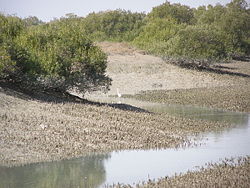Hara mangrove forests of Qeschm

Hara mangrove forests are mangrove forests in southern Iran mainly near and on the island of Qeschm in the Persian Gulf . The one of the species Avicennia marina (with the local name Hara or Harra , حرا) dominated forest forms an important ecological system that serves as a biosphere reserve and as such is under nature protection. The commercial use of the Hara forests is reduced to fishing (mainly shrimp ), tourist boat trips and the minor cutting down for animal feeding.
Features of the hara tree
The light-leaved Avicennia marina (Hara tree) usually grows to a height of three to seven meters. The saltwater plant , which sinks regularly in the tide, blooms in yellow flowers and bears a sweet almond-like fruit from July to August . As the water moves, the plant seeds are carried to quieter parts of the water, where they then germinate. The area between the north coast of Qeschm and the adjoining southern mainland coast is particularly suitable for this. For this reason you can also find extensive mangrove forests here . The tree's long, narrow, oval-shaped leaves are characterized by a high nutritional value for cattle breeding, which is almost equivalent to that of barley or alfalfa .
A filter system in the tree bark allows the plant to absorb water and desalinate it at the same time.
Extent and importance of the forest
The Harawald on Qeschm and the opposite mainland extends over an area of 20 square kilometers and is crossed by watercourses.
The area is an important habitat for migratory birds during the winter months, as well as for reptiles , various species of fish , arthropods and mussels . Green sea turtles and poisonous sea snakes also inhabit these forests. The native bird life here includes herons , flamingos , pelicans and eagles .
See also
Web links
- Article on the Hara mangrove forests on Minâb ( Memento from December 3, 2007 in the Internet Archive )
- Pictures on Fotopages.com
- Article about the island of Qeschm in Events Magazine (English)
Coordinates: 26 ° 50 ′ 0 ″ N , 55 ° 41 ′ 0 ″ E
